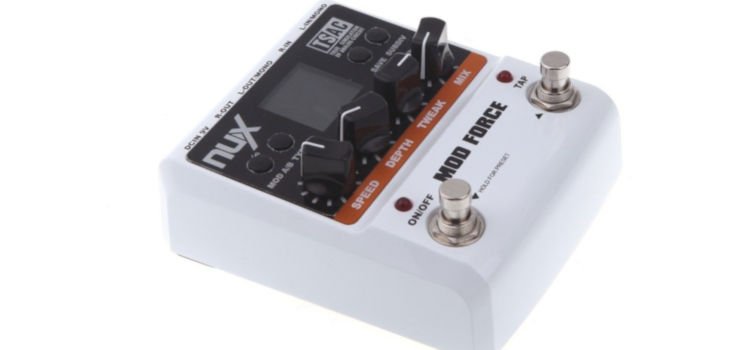NUX MOD Force Pedal Review

Published: 02/01/2019
Under: Guitar Gear Reviews
The NUX MOD Force Multi Modulation Effects Pedal is a pedal that I’ve been after for some time. I wanted one as it should enable me to simplify my pedalboard while still having great guitar tone.
The NUX MOD Force has 12 different types of modulation, the ability to store up to 9 presets, a kill dry function, tap tempo, and stereo inputs and outputs.
Description:
The NUX MOD Force has 12 different types of modulation effects, including Chorus, Flanger, Phaser, Tremolo, and Vibrato. So if you’re running a tremolo, chorus, and phaser on your pedalboard, for example, you could replace these three pedals with the MOD Force.
You would still have access to these different tones and more. Just without needing several pedals or a load of space on your pedalboard.
In addition to running one sound at a time, the pedal has a dual mode allowing you to combine two sounds (e.g. chorus with tremolo) at once.
The screen makes it easy to see what settings you’re using while also indicating what each of the four control knobs control.
In preset mode, the screen changes to show the preset number in a large, easy-to-read font.

Build Quality: 8/10
The pedal is well built, using good quality jacks, footswitches, and a metal enclosure. The screen is really easy to read in both modes, really useful in a gigging setting.
The two things that aren’t so great are the pots are not attached to the enclosure. So, if you knock the pedal, you could snap a control knob. And while it’s not an expensive pedal, breaking it isn’t something you want to happen.
And the power supply jack on the back isn’t fixed to the case. You’ll want to be careful when removing any power cable or you could tear it off. That said, you can also power the pedal using a 9-volt battery.
All in all, it’s a well-built FX pedal and should survive some gigging abuse.
Controls and Features: 8/10
There are a lot of controls, including a few that are hidden on this pedal. On the back, there’s a power socket, stereo inputs, and stereo outputs. The pedal can be run mono in and stereo out using the MOD force as the stereo split. A really useful feature for those who like to run in stereo.
First row of buttons:
MOD A/B – allows you to add a second modulation effect to the first and create a load more sounds.
Type – which of the 12 effect types you want to use.
Save – This button has a dual role. If you click it once, the screen will flash, and you’re now in preset mode. Using the tap tempo footswitch, you can cycle the presents until you find an empty one to save the sound.
If you hold it down for two seconds, it activates configuration mode, which allows you to set kill dry off/on, bypass type, and whether the pedals starts in preset or manual mode.
Also, in configuration mode, you can select whether you would like to use all 9 presets, only presets 1 – 3, only presets 4 – 6, or only presets 7 – 9.
Subdiv – allows you to select the note value for the tempo. You can set this from a whole note to an 8th and all other increments in between.
Second row of buttons:
There are 4 control knobs on the second row. These control different things depending on effect type, so check the screen to see what each knob control:
Speed – controls how fast or slow the effect is.
Depth – is how much effect you want.
Tweak – changes by effect type.
Mix – changes by effect type.
There are the two footswitches. In manual mode, the left is on/off, and the right controls the effect’s tempo by allowing you to tap the speed into the pedal.
If you hold down the left footswitch for 2 seconds, the pedal switches to preset mode. The left footswitch still controls on/off. The right cycles through the 9 presets, allowing you to recall previously saved sounds.
Tones and Sounds: 8/10
There are 12 different types of modulation effects: Chorus, Tri-Chorus, Flanger, Tape Flanger, Phaser, Bi-Phaser, Tremolo, Stereo Tremolo, Vibrato, Auto Wah, Rotary Speaker, and Uni-Vibe.
For gigs, I need a chorus sound (for 80s type stuff), tremolo, and phaser. I found that out of the two, the Tri-Chorus sounds the best as does the Bi-Phaser. The Tremolo sound is quite cool too. As quickly as I found sounds, I was able to save them to presets, enabling me to think more about playing the gig than tap dancing!
I’ve never got how to use a Flanger sound, so they sound classically weird but I can’t seem to find a use for them. I feel the same about the Vibrato effect.
The Auto-Wah and Rotary Speaker effects surprised me the most. The Auto-Wah is really usable and sounds phat!
The rotary speaker sound is best when the controls are turned most of the way up. I’d use this sound for Jazz comping or if I was asked to get that Avril Lavigne “complicated” / early 2000 pop rock sounds.
The Uni-Vibe sounds too much like a phaser on low settings to be useful. However, it has a more musical swoosh tone when you start to tweak the controls. It did find that this effect required a lot of tweaking with it to find a sound that would work live or in the studio.

Overall: NUX MOD Force Pedal
Rating: 9/10
Is the NUX MOD Force the best modulation pedal ever? No, it isn’t. However, is it a hugely versatile and inexpensive pedal? Yes.
I half expected it to sound cheap, thin, and be unusable. However, it sounds really good and is packed full of features, which are easy to use and understand. I think this pedal is just as good as the TC Electronic Nova Mod (no longer in production) or the modulation section of the Line6 M5 – just at a fraction of the price.
If you’re looking for a modulation pedal that covers a lot of ground, sounds good, can save/recall preset, and is user-friendly, consider the NUX MOD Force.






Leave a Reply